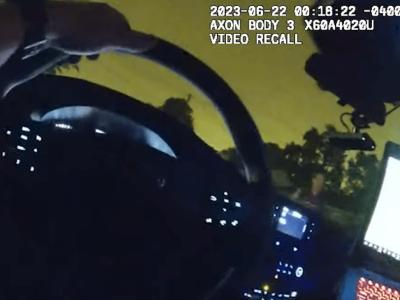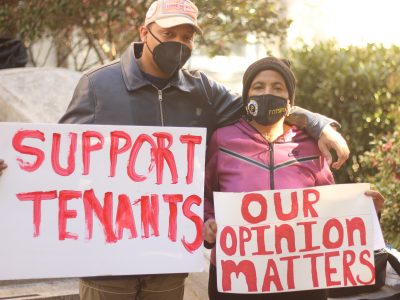by Jordan Green and Brian Clarey
Rev. Greg Drumwright leads a march through residential neighborhoods of Graham. (photo by Carolyn DeBerry)
Three days after volleys of police pepper spray disrupted a peaceful procession of mostly Black activists to the polls here, ending in mass arrests, injuries, and trauma to children caught in the mayhem, marchers returned in force.
Under the direction of Rev. Greg Drumwright, upwards of 650 people retraced the steps of the original march, a trip that took them from Wayman Chapel AME Church, to two polling places, and then to a Confederate monument, where a few-dozen counter-protesters met them.
The chaos that unfolded days earlier saw a disabled woman fall out of a motorized wheelchair after experiencing a seizure, and protesters — including at least three children — left vomiting, while others cried out in agony after becoming overcome by the chemical irritant.
This time around, the protest — in Alamance County, a Republican-leaning area where Trump needs to run up a sizable electoral margin to carry the crucial swing state of North Carolina — largely went off without incident. Ann Jones, one plaintiff in a lawsuit filed Monday over the violence at the last march, successfully cast her ballot Tuesday afternoon.
“I want you to give the beloved community a hand because we are here to stand with the citizens of Alamance County to run hate out of this county and to welcome love into it,” Drumwright said, addressing the crowd gathered at Wayman Chapel AME Church.
“Most of you have already voted in your hometowns and your respective districts,” he continued. “But you’re here to stand as a symbolic witness to celebrate the rights of all people, all people here to be able to cast their vote.”
Three police units idled in the parking lot of the polling place at the Graham Recreation Center. John Coleman, a Democratic candidate for the Alamance-Burlington Board of Education who was at the march Tuesday, noted of police:, “They can claim they’re here for parking, but everyone knows they’re here for voter intimidation.”
“When poll observers asked them what they’re here for, they wouldn’t answer,” he continued. “And they’re within 50 feet of a polling site.”

During the previous march, law enforcement’s insistence on keeping the streets clear around the Historic Courthouse was the point of friction they used to justify an attack on the marchers with pepper spray.
“They were under the same understanding that we were, we thought, when the event started that they were not authorized to keep the road closed for an extended period of time,” Graham Police Lt. Daniel Sisk said during a press conference on Sunday. “That the road closure was temporary just to accommodate the march, which we led by from the chapel, had road closures up to the courthouse, and when the order was given to clear the road, when it was clear to our officers that the people had no intent of clearing the road, that’s when we deployed the pepper-fogger measures to get them out of the roadway.”
After police and sheriff’s deputies deployed pepper spray for a third time during the Oct. 31 gathering, marchers fled north on Main Street and broke up, with few if any making it to the polling place a block west of the Confederate monument. It was the final day of early voting in North Carolina, during which voters may register and vote on the same day, but may only vote on Election Day if they’re already registered.
“There were folks that did not make it to vote,” Drumwright told Triad City Beat. “There are people who won’t get to vote, unfortunately, because they didn’t get to register on the last day of early voting. We’re sad because the police action resulted in voter obstruction.”
During the Election Day march, marchers scrupulously stayed on sidewalks or marched in ones and twos along one side of streets without sidewalks. The march wound through residential neighborhoods to pick up the two polling places. A brass band enlivened the march, and children ran to windows in houses along the route to greet the marchers.
Danielle Cattouse and her son, Kamren, filmed the march on their phones as they waited to exit a parking lot onto the street.
“This is amazing,” Danielle Cattouse said. “You’ve got to fight for something — democracy. It’s crazy how this nation is divided because of the man who is president.”
When the marchers reached the Historic Courthouse where the monument is located, protest marshals ushered them across the street to the courthouse steps, while a couple dozen counter-protesters waved Confederate flags, jeered, and chanted, “Four more years.” One man waving a Trump flag urged motorists to keep driving around the traffic circle to prevent marchers from getting across the street and bottle-neck them in the area where the counter-protesters were. He tried to start several fights and shoved a man. A parade marshal and a pastor approached him to de-escalate.
Alamance County, a semi-rural former textile hub tucked between Greensboro and Durham, has a long history of racism, going back to the lynching of Wyatt Outlaw, a Black town commissioner and constable, by the Ku Klux Klan in 1870. The Confederate monument, erected near the site of Outlaw’s lynching, has become a focal point of bitter conflict between antiracists and far-right pro-Confederate groups. Terry Johnson, the current sheriff, was sued by US Justice Department for racial profiling. A federal judge appointed by President George W. Bush ultimately dismissed the government’s case while condemning ethnic slurs used at the Alamance County jail as “reprehensible.” The government lawsuit cited Johnson for calling Latinx people “taco eaters,” and as recently as 2019, he told county commissioners that criminal immigrants were “raping our citizens.”
Antiracists have repeatedly called out what they see as a friendly relationship between Johnson and the monument supporters during repeated protests over the summer. In July, a federal judge ordered the city of Graham and the sheriff’s office to lift a ban on protest that had been in place at the monument off and on since protests erupted in the wake of the police killing of George Floyd. On Monday evening, Drumwright filed a federal lawsuit against Sheriff Johnson and Graham police Chief Kristy Cole, claiming violations of their First and Fourth Amendment rights, along with the violations of the Voting Rights Act and Ku Klux Klan Act of 1871.
Drumwright said protesters will continue to pressure local officials for police reform in Alamance County, and is calling on state and federal authorities to investigate.
“People in Alamance County don’t feel safe,” he said. “If you’re Black in Alamance County, if you’re Hispanic, you don’t feel safe calling the police. “‘Every demonstration we’ve done throughout this entire summer I’ve been told by people I look up to not to do it,” he said. “We need the organizers of yesterday to know the organizers of today are not going to stop until we see justice for the next generation.”
This story was produced in partnership with the Daily Beast.
Join the First Amendment Society, a membership that goes directly to funding TCB‘s newsroom.
We believe that reporting can save the world.
The TCB First Amendment Society recognizes the vital role of a free, unfettered press with a bundling of local experiences designed to build community, and unique engagements with our newsroom that will help you understand, and shape, local journalism’s critical role in uplifting the people in our cities.
All revenue goes directly into the newsroom as reporters’ salaries and freelance commissions.





Leave a Reply